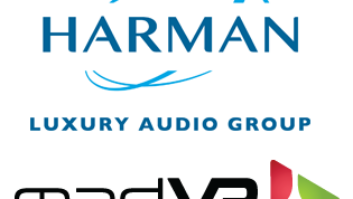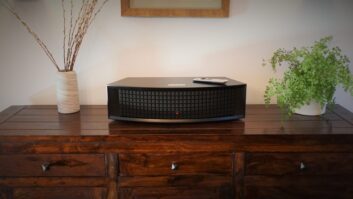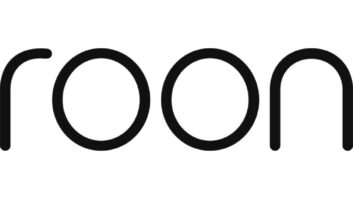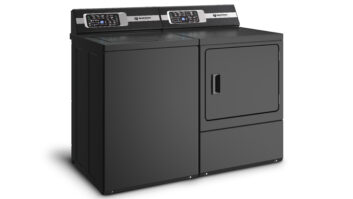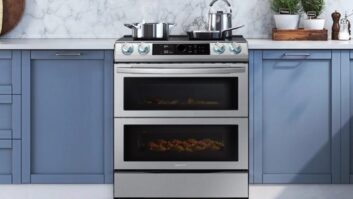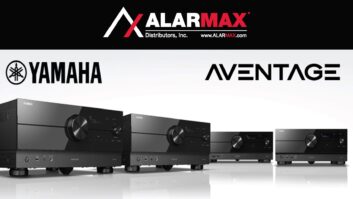Stamford, Conn. – Harman International is rolling out a dozen new Harman Kardon and JBL home audio products, including HK’s first A/V receiver with Apple AirPlay, new opening price points on HK AVRs, and an expanded selection of JBL active soundbars and iPad-docking speaker systems.
All ship in October along with a new series of Infinity Kappa car speakers.
The new Harman Kardon products include the $299-suggested AVR 700 and $499 AVR 1700 5.1-channel AVRs, the brand’s first stereo-Bluetooth adapter to add Bluetooth streaming to any audio system, and a new version of HK’s SoundSticks 2.1 multimedia speaker system, this one adding stereo Bluetooth.
In AVRs, the new $299 model features Dolby TrueHD and DTS-HD Master surround decoding, 5×75-watt amp, three HDMI 1.4a inputs, HDMI 1.4a output with audio return channel, and a front-panel USB to play MP3 files from USB sticks, drives and compatible Android phones.
HK’s $499 AVR 1700 steps up to add 5×100-watt amp, DLNA 1.5-certified networking to PCs and mobile devices, Apple AirPlay, vTuner Internet radio, and Apple-certified USB for playing music from and charging Apple’s mobile devices, including the iPad. The AVR 1700 is also the brand’s first AVR with iOS and Android remote-control apps. The AVR also features six HDMI 1.4a inputs and flush volume control.
Harman Kardon’s previous opening price point for AVRs was $479, and the opening price on networked AVRs was $879, the company’s web site shows.
To add Bluetooth capability to any audio system, HK is launching the $59-suggested BTA 10, a 2×2-inch module that connects to any audio via stereo RCA inputs and 3.5mm aux input. It can be paired with up to eight Bluetooth devices. Harman TrueStream technology is designed to improve sound quality.
Bluetooth is also a feature of HK’s new $229 SoundSticks Wireless multimedia speakers, which add Bluetooth streaming to their predecessor’s feature set. The 40-watt three-piece system consists of two vertical satellites, each with four full-range drivers, and a separate 6-inch downfiring subwoofer with volume control. The system connects to PCs and audio sources via 3.5mm aux in or by Bluetooth. It also features TrueStream technology and ability to pair with eight Bluetooth sources.
Under the JBL brand, the company is expanding its soundbar selection with three models priced at a suggested $199, $299, and $549. The brand previously offered a $599 bar. All three are two- or 2.1-channel models with proprietary signal processing to simulate surround sound.
The top two soundbars are JBL’s first with built-in Bluetooth. All three feature EQ switch to optimize response for wall mounting or table placement.
The JBL Cinema SB 100 soundbar at $199 features 2×30-watt amp, bass-boost button, a pair of tweeters and woofers, RCA output to add a powered subwoofer, and ability to learn the IR codes of TV and settop-box remotes. It’s for TV up to 32 inches.
The $299 SB200 adds Bluetooth, 2×60-watt amp, Dolby Digital decoder, two tweeters and two woofers, and built-in subwoofer. It’s for TVs with 32- to 40-inch screen sizes. The $549 SB400 features 2×60-watt amp but adds wireless 8-inch 200-watt subwoofer.
In docking speakers, JBL launched the $139-suggested OnBeat aWake and $199 OnBeat Venue, both of which are the brand’s first docking speakers with Bluetooth. Both feature Apple-certified 30-pin dock for iPods, iPhones and iPads. They also feature TrueStream to enhance Bluetooth sound and the ability to pair with eight Bluetooth devices.
The $139 aWake doubles as an alarm clock with or without a docked iOS device. It features multiple alarm settings, snooze bar, and a free app with customized music settings for waking and falling asleep, on-screen personal calendar, AccuWeather weather reports, and more than 20 wallpaper styles that include analog and digital clock styles.
JBL’s $199 OnBeat Venue features pop-out 30-pin dock connector behind a JBL logo, SlipStream port to enhance bass output, component-video output, and a free MusicFlow app that lets users create custom playlists, edit mixes, adjust volume and EQ, and browse album art.
Two of JBL’s three new JBL portable AC/DC speakers feature Bluetooth. Those two are the cylindrical $99 Flip, which can be placed horizontally or vertically. It features stereo speakers, bass port, and DSP to extend frequency response at the high and low ends. It also features built-in microphone for hands-free use and a five-hour rechargeable battery.
The other Bluetooth speaker is the pocket-size disc-shaped $59 Micro Wireless with single driver and rechargeable five-hour battery. Both Bluetooth speakers also feature 3.5mm aux in.
The $39 Micro II portable speaker lacks Bluetooth and features aux in. It and the Micro Wireless can be daisychained with additional Micro models to boost volume.
In car audio, the Infinity brand launched eight speakers in the all-new Kappa series at suggested retails from $159 to $349. Two- and three-way speakers feature reduced mounting depths, and most two-way models feature UniPivot pivoting tweeter. The sole three-way speaker is a 6×9, and one speaker is a two-way 4×6-inch component plate speaker. All models feature user-adjustable tweeter-level control.
The line also includes a component tweeter.
“In the face of rising material costs and other companies removing content at the expense of performance, we held the line on performance and introduced a killer new line at slightly higher prices,” a spokesman said.
“Mounting depth has been reduced for an easier fit into many cars. The crossover dongle has been eliminated, and the high-order crossover circuit has been integrated into the basket for easier installation,” he continued. “The speakers include gold-plated screw terminals rather than the standard spade terminals. The tweeter is all new and provides improved performance. Performance and fit and finish is superior to every competing model, even those costing as much as 50 more.”




